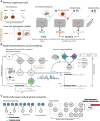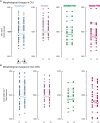Plasticity of human resilience mechanisms
- PMID: 39772669
- PMCID: PMC11708882
- DOI: 10.1126/sciadv.adq8336
Plasticity of human resilience mechanisms
Abstract
The hippocampus's vulnerability to trauma-induced stress can lead to pathophysiological disturbances that precipitate the development of posttraumatic stress disorder (PTSD). The mechanisms of resilience that foster remission and mitigate the adverse effects of stress remain unknown. We analyzed the evolution of hippocampal morphology between 2016/2017 and 2018/2019, as well as the memory control mechanisms crucial for trauma resilience. Participants were individuals exposed to the 2015 Paris terrorist attacks (N = 100), including chronic (N = 34) and remitted (N = 19) PTSD, and nonexposed (N = 72). We found that normalization of inhibitory control processes, which regulate the resurgence of intrusive memories in the hippocampus, not only predicted PTSD remission but also preceded a reduction in traumatic memories. Improvement in control mechanisms was associated with the interruption of stress-induced atrophy in a hippocampal region that includes the dentate gyrus. Human resilience to trauma is characterized by the plasticity of memory control circuits, which interacts with hippocampal neuroplasticity.
Figures






Similar articles
-
Resilience after trauma: The role of memory suppression.Science. 2020 Feb 14;367(6479):eaay8477. doi: 10.1126/science.aay8477. Science. 2020. PMID: 32054733
-
Hippocampal activation during contextual fear inhibition related to resilience in the early aftermath of trauma.Behav Brain Res. 2021 Jun 25;408:113282. doi: 10.1016/j.bbr.2021.113282. Epub 2021 Apr 2. Behav Brain Res. 2021. PMID: 33819532 Free PMC article.
-
Genetic variation is associated with PTSD risk and aversive memory: Evidence from two trauma-Exposed African samples and one healthy European sample.Transl Psychiatry. 2018 Nov 22;8(1):251. doi: 10.1038/s41398-018-0297-1. Transl Psychiatry. 2018. PMID: 30467376 Free PMC article.
-
Hippocampal volume deficits associated with exposure to psychological trauma and posttraumatic stress disorder in adults: a meta-analysis.Prog Neuropsychopharmacol Biol Psychiatry. 2010 Oct 1;34(7):1181-8. doi: 10.1016/j.pnpbp.2010.06.016. Epub 2010 Jun 21. Prog Neuropsychopharmacol Biol Psychiatry. 2010. PMID: 20600466 Review.
-
Olfaction as a traumatic reminder in posttraumatic stress disorder: case reports and review.J Clin Psychiatry. 2003 Feb;64(2):202-7. doi: 10.4088/jcp.v64n0214. J Clin Psychiatry. 2003. PMID: 12633130 Review.
Cited by
-
The Involvement of the Endocannabinoid, Glutamatergic, and GABAergic Systems in PTSD.Int J Mol Sci. 2025 Jun 20;26(13):5929. doi: 10.3390/ijms26135929. Int J Mol Sci. 2025. PMID: 40649707 Free PMC article. Review.
-
Brain mechanisms underlying the inhibitory control of thought.Nat Rev Neurosci. 2025 Jul;26(7):415-437. doi: 10.1038/s41583-025-00929-y. Epub 2025 May 16. Nat Rev Neurosci. 2025. PMID: 40379896 Review.
-
Impact of the Covid-19 pandemic and lockdown on the mental health of people exposed to the terrorist attacks of 13 November 2015.BMC Psychiatry. 2025 Jul 24;25(1):724. doi: 10.1186/s12888-025-07134-2. BMC Psychiatry. 2025. PMID: 40707896 Free PMC article.
References
-
- Kalisch R., Baker D. G., Basten U., Boks M. P., Bonanno G. A., Brummelman E., Chmitorz A., Fernàndez G., Fiebach C. J., Galatzer-Levy I., Geuze E., Groppa S., Helmreich I., Hendler T., Hermans E. J., Jovanovic T., Kubiak T., Lieb K., Lutz B., Müller M. B., Murray R. J., Nievergelt C. M., Reif A., Roelofs K., Rutten B. P. F., Sander D., Schick A., Tüscher O., Diest I., van Harmelen A.-L., Veer I. M., Vermetten E., Vinkers C. H., Wager T. D., Walter H., Wessa M., Wibral M., Kleim B., The resilience framework as a strategy to combat stress-related disorders. Nat. Hum. Behav. 1, 784–790 (2017). - PubMed
-
- van Rooij S. J. H., Santos J. L., Hinojosa C. A., Ely T. D., Harnett N. G., Murty V. P., Lebois L. A. M., Jovanovic T., House S. L., Bruce S. E., Beaudoin F. L., An X., Neylan T. C., Clifford G. D., Linnstaedt S. D., Germine L. T., Bollen K. A., Rauch S. L., Haran J. P., Storrow A. B., Lewandowski C., Musey P. I., Hendry P. L., Sheikh S., Jones C. W., Punches B. E., Swor R. A., Pascual J. L., Seamon M. J., Harris E., Pearson C., Peak D. A., Merchant R. C., Domeier R. M., Rathlev N. K., O’Neil B. J., Sanchez L. D., Joormann J., Pizzagalli D. A., Sheridan J. F., Harte S. E., Kessler R. C., Koenen K. C., McLean S. A., Ressler K. J., Stevens J. S., Defining the r factor for post-trauma resilience and its neural predictors. Nat. Ment. Health 2, 680–693 (2024).
-
- Yehuda R., LeDoux J., Response variation following trauma: A translational neuroscience approach to understanding PTSD. Neuron 56, 19–32 (2007). - PubMed
MeSH terms
LinkOut - more resources
Full Text Sources
Medical

